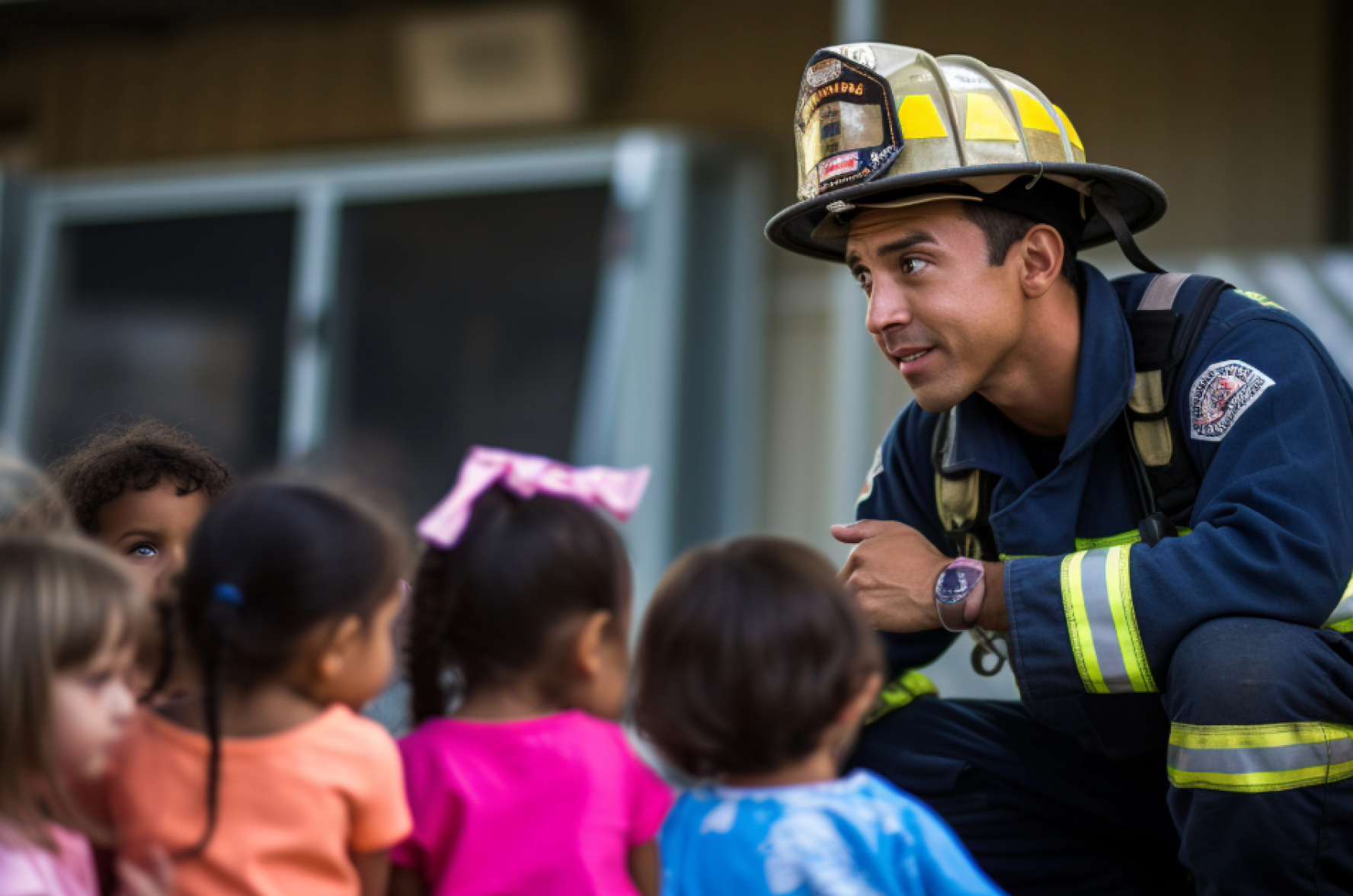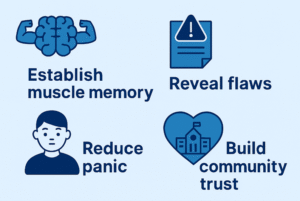News

Rethinking School Safety Drills: Building Confidence, Not Just Compliance
School safety drills have long been a cornerstone of emergency preparedness — from fire drills and lockdown protocols to active shooter simulations, all of which are outlined in comprehensive emergency planning guidance from SchoolSafety.gov. But in today’s dynamic threat environment, simply conducting drills isn’t enough. It’s not about going through the motions; it’s about cultivating a culture of readiness that empowers every educator, administrator, and student to respond with clarity and confidence.
This blog explores the evolving role of school safety drills, how they can be optimized for real-world scenarios, and why schools must rethink their current strategies to match the pace of emerging school safety challenges driven by evolving threats and technology. For a deeper dive into SimulAlert’s approach to emergency preparedness, check out our post on prioritizing school safety and security.
Why School Safety Drills Still Matter
Although some may see them as routine disruptions, safety drills are essential for multiple reasons:
- They establish muscle memory. In moments of crisis, the brain reverts to instinct. Well-practiced drills help automate decisions and actions under stress.
- They reveal system flaws. Drills expose gaps in communication, access control, and staff coordination that would otherwise go unnoticed.
- They reduce panic. Familiarity with safety protocols can significantly reduce fear during real emergencies, especially for students.
- They build community trust. When schools take safety seriously, parents and communities feel more confident in their leadership.

Figure 1: Benefits of School Safety Drills
The Drill Dilemma: When Routine Becomes Risk
Despite their benefits, many schools fall into a trap: drills that are too predictable, too infrequent, or too disconnected from real-life threats. Here are some common issues:
- Lack of Scenario Variety
Repeating the same fire drill every month won’t prepare staff for medical emergencies, intruders, or environmental threats. A limited approach leaves critical gaps in readiness.
- Drill Fatigue and Desensitization
Excessive drills without meaningful context can erode their impact. When staff and students are repeatedly exposed to alerts that feel routine or disconnected from real-world scenarios, they may become desensitized — a risky mindset in the face of genuine emergencies. This desensitization is often compounded by frequent false alerts, which can be just as emotionally jarring as actual threats. Single button wearable badge systems are prone to these false alerts. When safety systems trigger too many false alarms, schools risk falling into a “boy who cried wolf” scenario, where critical warnings are ignored or downplayed.
- Over-Reliance on Announcements
Drills are often communicated via intercoms or announcements, assuming everyone hears and understands the same message. In reality, noise, stress, and location can all interfere.
- No Real-Time Feedback
Drills are rarely followed by structured debriefs. Without immediate feedback or visibility into how the situation was handled, mistakes go uncorrected.
Moving from Compliance to Capability
Safety drills should be more than a checkbox for state mandates. To be truly effective, they must train staff and students to adapt, respond, and lead under pressure. This shift requires several changes:
- Drills Aligned with Real-World Threats
Schools must create diverse drill schedules that reflect all types of emergencies—not just the most common ones. This includes:
- Medical scenarios: Do teachers know how to call for a nurse if a student collapses?
- Weather-related drills: Do staff know what to do during tornado or earthquake warnings?
- Behavioral threats: Can your school isolate a hallway altercation without causing a school-wide lockdown?
For a broader overview of best practices, see BeSafe’s guide to school safety drills
- Tiered Response Training
Not every incident requires a full lockdown. Schools should train staff to differentiate between:
- Medical emergencies
- Administrative assistance
- Security threats
- Evacuation events
Using a color-coded or tiered system helps avoid overreaction and ensures the right help is dispatched. Transitioning from traditional paper-based systems to technology can greatly enhance communication, speed, and clarity. The U.S. Secret Service’s NTAC highlights how multi-tiered systems of support can align with behavioral threat assessment to improve school safety outcomes.
- Role-Specific Drills
A single script doesn’t work for everyone. Front office staff, janitors, cafeteria workers, and teachers all have different responsibilities during emergencies.
Drills should be tailored accordingly to ensure clarity and confidence across roles. The Texas School Safety Center emphasizes the importance of inclusive, role-specific training that accounts for staff diversity and student needs.
Best Practices for School Safety Drills
Here’s how to build drills that truly strengthen emergency preparedness:

Involve security directors, teachers, nurses, and even local law enforcement in planning. Different perspectives ensure the plan is thorough and realistic.

Conduct unannounced drills once staff are familiar with procedures. This reveals real reactions and strengthens adaptability.

Time how long it takes to:
- Notify administrators
- Secure doors
- Dispatch responders
- Account for students
- Start re-unification
Benchmarking these metrics allows schools to improve over time.

Drills should test the systems you’ll use in an emergency — from communication platforms to alert systems and digital dashboards. See our previous blog on “how-technology is transforming emergency alert systems in schools”.

Hold debriefs with staff and student leaders. Ask:
- What was unclear?
- What worked well?
- What can be improved?
Use this feedback to evolve and improve your plan — drills should be living, breathing exercises. Consider using tabletop exercises to address any gaps that are identified in drills.
Empowering Staff Through Better Tools
Even the best drills can’t replace the value of real-time communication and simplified decision-making. When emergencies occur, staff must:
- Signal clearly what type of help is needed
- Know exactly what to do, with no guesswork
- Access support instantly, without fumbling with phones or apps
Training helps, but tools matter just as much. If your alert system creates confusion, or is prone to false alarms, no amount of drill practice will make it effective.
What to Avoid in Safety Drills
Drills can backfire if poorly implemented. Avoid:

If staff are unsure of what button to press (or how many times to press a button), or which code means what, your drill will create chaos — not clarity.

Avoid relying solely on phones, Wi-Fi, or complicated software that may not work under stress.

Ensure your safety communication is effective for staff or students with hearing, visual, or mobility impairments.
Legal Compliance: Drills + Technology
Many states mandate a minimum number of drills per year. But increasingly, laws like Alyssa’s Law also require panic button systems that connect directly to law enforcement.
Schools that blend regular drills with compliant alert systems are in the best position to:
- Satisfy legal requirements
- Build trust with communities
- Actually protect lives when seconds matter
The Culture Factor: From Mandate to Mindset
Effective safety protocols only work when people believe in them. School leadership must:
- Champion the importance of preparedness
- Celebrate successful drills and improvements
- Provide ongoing training and support
- Use student and staff feedback to guide change
When everyone is on board, safety becomes part of the school’s DNA — not just a requirement on paper.
Conclusion: SimuAlert Makes Drills Work Smarter
At SimulAlert®, we believe drills should support — not replace — real response tools. That’s why our color-coded badge system is designed to eliminate false alerts & confusion and accelerate action when it matters most.
With SimulAlert:
- Every staff member knows exactly how to signal for help.
- Alerts are clear, intentional, and specific — medical, lockdown, admin assist.
- Real-time dashboards give administrators total visibility.
- No phones, Wi-Fi, or apps required.
When paired with regular, scenario-based drills, SimulAlert doesn’t just meet compliance — it builds confidence.

Click here to schedule a SimulAlert® demo.



